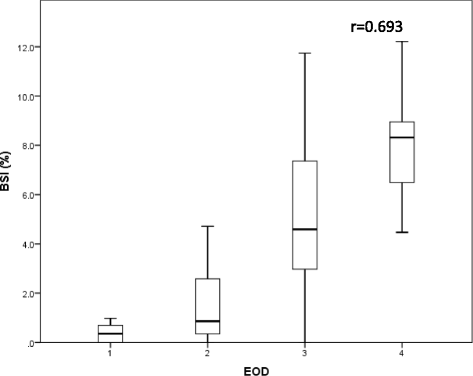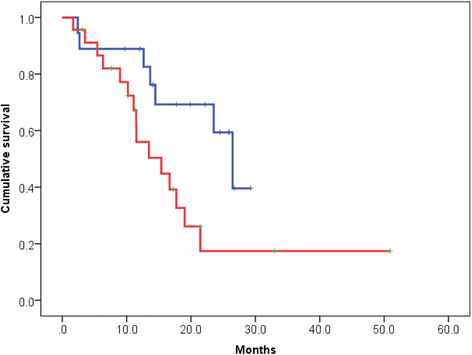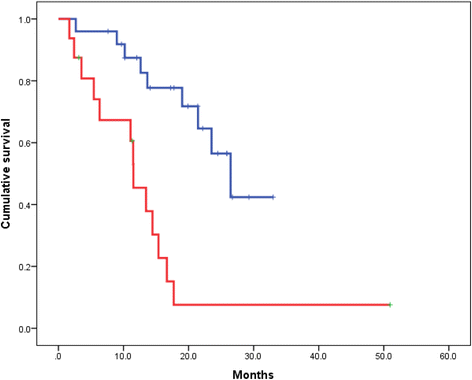Prognostic value of a computer-aided diagnosis system involving bone scans among men treated with docetaxel for metastatic castration-resistant prostate cancer
- PMID: 26883015
- PMCID: PMC4755022
- DOI: 10.1186/s12885-016-2160-1
Prognostic value of a computer-aided diagnosis system involving bone scans among men treated with docetaxel for metastatic castration-resistant prostate cancer
Abstract
Background: The bone scan index (BSI), which is obtained using a computer-aided bone scan evaluation system, is anticipated to become an objective and quantitative clinical tool for evaluating bone metastases in prostate cancer. Here, we assessed the usefulness of the BSI as a prognostic factor in patients with metastatic castration-resistant prostate cancer (mCRPC) treated using docetaxel.
Methods: We analyzed 41 patients who received docetaxel for mCRPC. The Bonenavi system was used as the calculation program for the BSI. The utility of the BSI as a predictor of overall survival (OS) after docetaxel was evaluated. The Cox proportional hazards model was used to investigate the association between clinical variables obtained at docetaxel treatment, namely PSA, patient age, liver metastasis, local therapy, hemoglobin (Hb), lactase dehydrogenase (LDH), albumin (Alb), PSA doubling time, and BSI and OS.
Results: The median OS after docetaxel therapy was 17.7 months. Death occurred in 22 (53.7%) patients; all deaths were caused by prostate cancer. In multivariate analysis, three factors were identified as significant independent prognostic biomarkers for OS after docetaxel; these were liver metastases (yes vs no; HR, 3.681; p = 0.026), Alb (<3.9 vs ≥ 3.9; HR, 3.776; p = 0.020), and BSI (>1% vs ≤ 1%; HR, 3.356; p = 0.037). We evaluated the discriminatory ability of our models including or excluding the BSI by quantifying the c-index. The BSI improved the c-index from 0.758 to 0.769 for OS after docetaxel. CRPC patients with a BSI >1 had a significantly shorter OS than patients with a BSI ≤ 1 (p = 0.029).
Conclusions: The BSI, liver metastases and Alb were independent prognostic factors for OS after docetaxel. The BSI might be a useful tool for risk stratification of mCRPC patients undergoing docetaxel treatment.
Figures





References
-
- Huggins C, Hodges CV. Studies on prostatic cancer I: the effect of castration, of estrogen, and of androgen injection on serum phosphatases in metastatic carcinoma of the prostate. Cancer Res. 1941;1:293–297. - PubMed
-
- Small EJ, Vogelzang NJ. Second-line hormonal therapy for advanced prostate cancer: a shifting paradigm. J Clin Oncol. 1997;15(1):382–388. - PubMed
-
- Petrylak DP, Tangen CM, Hussain MH, Lara Jr PN, Jones JA, Taplin ME, Burch PA, Berry D, Moinpour C, Kohli M et al. Docetaxel and estramustine compared with mitoxantrone and prednisone for advanced refractory prostate cancer. N Engl J Med. 2004;351(15):1513–20. - PubMed
-
- Tannock IF, de Wit R, Berry WR, Horti J, Pluzanska A, Chi KN, Oudard S, Theodore C, James ND, Turesson I et al. Docetaxel plus prednisone or mitoxantrone plus prednisone for advanced prostate cancer. N Engl J Med. 2004;351(15):1502–12. - PubMed
Publication types
MeSH terms
Substances
LinkOut - more resources
Full Text Sources
Other Literature Sources
Medical
Research Materials
Miscellaneous

